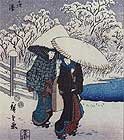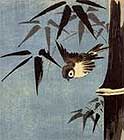

Tales
of Old Japan
by Algernon Bertram Freeman-Mitford
The Loves of Gompachi and Komurasaki
A
Story of the Otokodate of Yedo
The Wonderful Adventures of Funakoshi Jiuyemon
The Eta Maiden and the Hatamoto
The
Accomplished and Lucky Tea-Kettle
The Story of the Old Man Who Made Withered Trees to Blossom
The Battle of the Ape and the Crab
The Adventures of Little Peachling
The Elves and the Envious Neighbour
How Tajima Shume Was Tormented By a Devil of His Own Creation
Concerning Certain Superstitions
How a Man Was Bewitched and Had His Head Shaved By the Foxes
The Accomplished and Lucky Tea-Kettle
A LONG time ago, at a temple called Morinji, in the province of Jôshiu, there was an old tea-kettle. One day, when the priest of the temple was about to hang it over the hearth to boil the water for his tea, to his amazement, the kettle all of a sudden put forth the head and tail of a badger. What a wonderful kettle, to come out all over fur! The priest, thunderstruck, called in the novices of the temple to see the sight; and whilst they were stupidly staring, one suggesting one thing and another, the kettle, jumping up into the air, began flying about the room. More astonished than ever, the priest and his pupils tried to pursue it; but no thief or cat was ever half so sharp as this wonderful badger-kettle. At last, however, they managed to knock it down and secure it; and, holding it in with their united efforts, they forced it into a box, intending to carry it off and throw it away in some distant place, so that they might be no more plagued by the goblin. For this day their troubles were over; but, as luck would have it, the tinker who was in the habit of working for the temple called in, and the priest suddenly bethought him that it was a pity to throw the kettle away for nothing, and that he might as well get a trifle for it, no matter how small. So he brought out the kettle, which had resumed its former shape and had got rid of its head and tail, and showed it to the tinker. When the tinker saw the kettle, he offered twenty copper coins for it, and the priest was only too glad to close the bargain and be rid of his troublesome piece of furniture. But the tinker trudged off home with his pack and his new purchase. That night, as he lay asleep, he heard a strange noise near his pillow; so he peeped out from under the bedclothes, and there he saw the kettle that he had bought in the temple covered with fur, and walking about on four legs. The tinker started up in a fright to see what it could all mean, when all of a sudden the kettle resumed its former shape. This happened over and over again, until at last the tinker showed the tea-kettle to a friend of his, who said, "This is certainly an accomplished and lucky tea-kettle. You should take it about as a show, with songs and accompaniments of musical instruments, and make it dance and walk on the tight rope."
The tinker, thinking this good advice, made arrangements with a showman, and set up an exhibition. The noise of the kettle's performances soon spread abroad, until even the princes of the land sent to order the tinker to come to them; and he grew rich beyond all his expectations. Even the princesses, too, and the great ladies of the court, took great delight in the dancing kettle, so that no sooner had it shown its tricks in one place than it was time for them to keep some other engagement. At last the tinker grew so rich that he took the kettle back to the temple, where it was laid up as a precious treasure, and worshipped as a saint.
The text came from:
Freeman-Mitford,
A. B. Tales of Old Japan. London: Macmillan, 1871, 1890.
Amazon.com:
Buy the book in paperback.
©Heidi
Anne Heiner, SurLaLune Fairy Tales
E-mail: surlalune@aol.com
Page last updated June 1, 2005
www.surlalunefairytales.com







